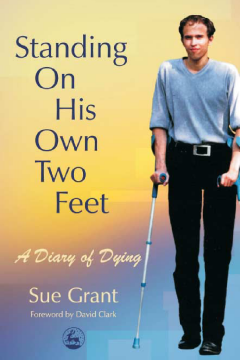
Additional Information
Book Details
Abstract
Alexander had just begun his studies at university when he was diagnosed with a rare bone cancer. In this honest account, Alex's mother traces the impact of the diagnosis on the whole family and outlines the issues that arose during diagnosis, treatment and terminal stages of her son's illness.
Standing on His Own Two Feet offers an insight into how health care systems serve the terminally ill, the choices faced by families, and ways of providing the best possible care at home and maintaining the patient's dignity until the end. In particular, Sue Grant deals sensitively with the care needs of young adults.
Portraying a family of admirable resilience and strength, this inspiring and moving book offers support and practical tips for anybody encountering terminal illness and presents valuable discussion points for all nursing, health and social care professionals.
Sue Grant lives with her family in Germany, where for 16 years she was a teacher in adult education. The cancer of her eldest son was the starting point of her writing career, and she now works as freelance journalist. She is a columnist with Bereavement, USA, contributing editor and book review editor for Compassion, UK, and belongs to the editorial team for the International Confederation of Childhood Cancer Parents' Organizations.
` Alexandra had just begun his studies at university when he was diagnosed with a rare bone cancer. In this honest account, Alex's mother traces the impact of the diagnosis, treatment and terminal stages of her son's illness'.
Human Givens
`Although I have been immersed in these issues about 15 years, this book gripped me and moved me profoundly. It manages to achieve sensitivity without sentimentality, and highlights the humanity and dignity of Alexander and his family, during some very undignified experiences…This book needs to be read by everyone.'
Myrna Whiteson, The Teenage Cancer Trust, UK
Table of Contents
| Section Title | Page | Action | Price |
|---|---|---|---|
| Acknowledgements vii | |||
| Introduction 1 | |||
| Chapter 1 Know Your Hazards 4 | |||
| Hazard awareness, 4 | |||
| Earthquakes, 6 | |||
| Further reading on earthquakes, 7 | |||
| Wind storms, 8 | |||
| Further reading on wind storms, 11 | |||
| Floods, 12 | |||
| Further reading on floods, 15 | |||
| Land instabilities, 16 | |||
| Further reading on land instabilities, 18 | |||
| Chapter 2 Choosing a Safe Site 19 | |||
| Siting and safety, 19 | |||
| Siting a settlement, 19 | |||
| Siting a building, 21 | |||
| Safe siting in flood hazard areas, 22 | |||
| Safe siting in areas with land instabilities, 23 | |||
| Safe siting in wind-prone areas, 25 | |||
| Safe siting in earthquake areas, 26 | |||
| Further reading on safe siting, 27 | |||
| Chapter 3 Building Safely in Brick and Block 28 | |||
| Masonry and hazards, 28 | |||
| Robust building form, 29 | |||
| Firm foundations, 30 | |||
| Good-quality materials, 32 | |||
| Strong walls, 33 | |||
| Distributed openings, 35 | |||
| Horizontal reinforcement, 36 | |||
| Safe modifications, 37 | |||
| Regular maintenance, 38 | |||
| Summary, 40 | |||
| Further reading on building safely in brick and block, 40 | |||
| Chapter 4 Building Safely in Earth and Stone Weak masonry and hazards, 41 | |||
| Good practice, 43 | |||
| Robust layout, 45 | |||
| Ring beam, 46 | |||
| Summary, 47 | |||
| Further reading on building safely in earth and stone, 47 | |||
| Chapter 5 Building Safely in Timber 48 | |||
| Timber and hazards, 48 | |||
| Why timber? 50 | |||
| Good foundations, 51 | |||
| Rigid vertical structure, 51 | |||
| Braced floors and roofs, 53 | |||
| Strong connections, 54 | |||
| Regular maintenance, 54 | |||
| Protect against fire, 55 | |||
| Summary, 56 | |||
| Further reading on building safely in timber, 56 | |||
| Chapter 6 Building Safely in Reinforced Concrete 57 | |||
| Reinforced concrete and hazards, 57 | |||
| Why concrete? 58 | |||
| Robust building form, 59 | |||
| Regular frame, 60 | |||
| Attention to element design, 64 | |||
| High-quality construction, 65 | |||
| Summary, 68 | |||
| Further reading on building safely in reinforced concrete, 69 | |||
| Chapter 7 Building a Safe Roof | |||
| Roofs and hazards, 70 | |||
| Aerodynamic roof form, 71 | |||
| Roof connected to structure, 71 | |||
| Well-fixed roof covering, 72 | |||
| Regular maintenance, 73 | |||
| Summary, 74 | |||
| Further reading on building a safe roof, 74 |
